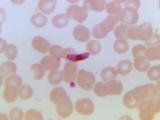Apr 26, 2010
Researchers make headway on Cryptosporidium targets
In the fight against Cryptosporidium, a waterborne protozoan parasite that commonly causes diarrhea and malnutrition and is a potential bioterrorism agent, researchers from Brandeis University identified a key enzyme that plays a role in the pathogen's RNA and DNA synthesis, along with more than 50 compounds so far that can inhibit the enzyme. They reported their findings yesterday at the American Society for Biochemistry and Molecular Biology's annual meeting in Anaheim, Calif. A number of the compounds showed antiparasitic activity. The research group is working on the first step in the drug development process, which is improving the compounds' potency, bioavailability, and metabolic stability. Cryptosporidum outbreaks have been linked to contaminated water supplies, and infections can be fatal in people who have weakened immune systems. Oocysts remain stable outside the host for long periods and resist
the usual water treatments such as chlorine disinfection. In 1993 in the nation's largest waterborne disease outbreak, Cryptosporidium contaminated Milwaukee's water supply, killing more than 100 people and sickening about 400,000 more.
Apr 25 Federation of American Societies for Experimental Biology press release
WHO partners clear more malaria rapid tests
A recent analysis of 29 rapid tests used to diagnose and treat malaria found that 15 met minimum performance measures set by the World Health Organization (WHO), raising the number of approved tests to 37 and offering endemic countries a wider choice of tests, the WHO reported on Apr 23. The testing is sponsored by the WHO and several global health partners, and the tests were performed at the US Centers for Disease Control and Prevention (CDC) in Atlanta. Dr Robert Newman, who directs the WHO's global malaria program, said in the statement that rapid tests have been a major breakthrough in malaria control, because they enable testing without microscopy in remote areas where most malaria occurs. The WHO's most recent malaria treatment guidelines advise clinicians to establish the malaria diagnosis through microscopy or rapid tests before treating patients. A more definitive diagnosis helps health workers gauge which febrile patients need
antimalarial drugs. Malaria is linked to 860,000 deaths a year, with the biggest burden in African children. Yesterday was World Malaria Day.
Apr 23 WHO press release




















